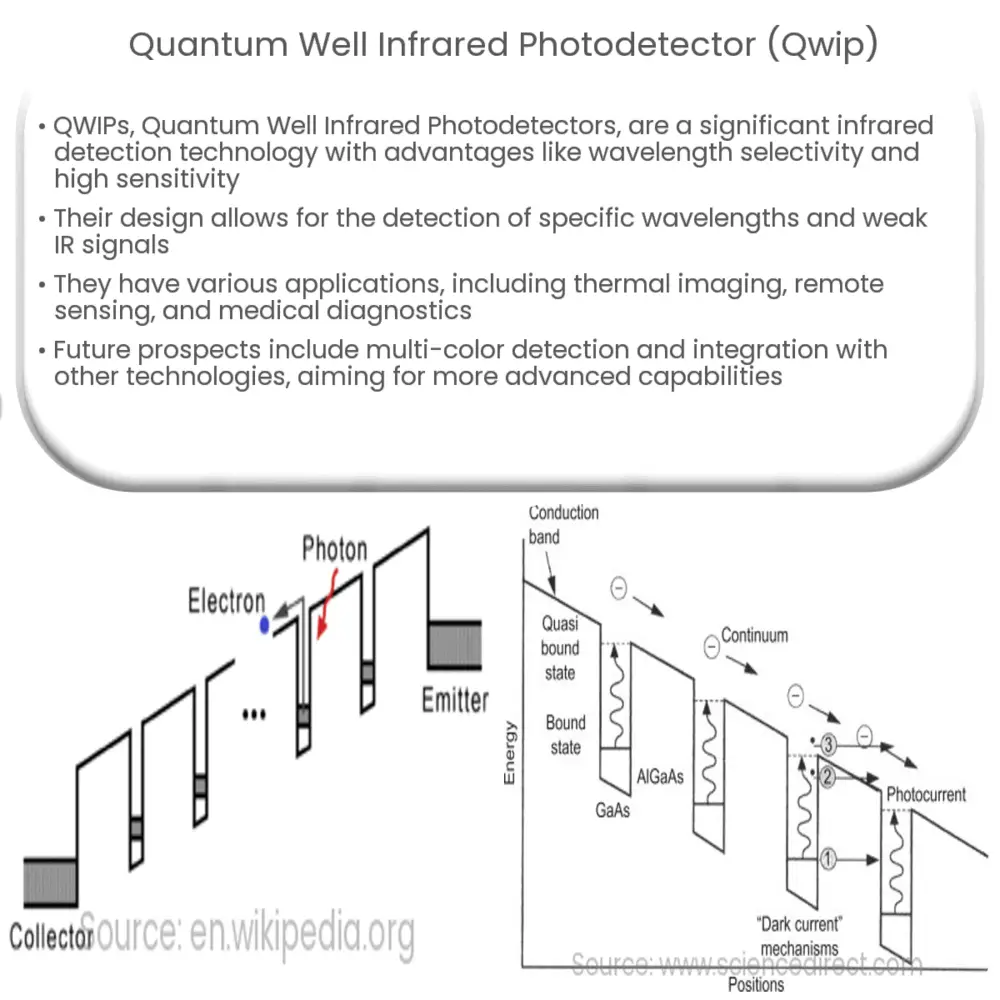Quantum Well Infrared Photodetectors (QWIPs) are high-performance, wavelength-selective IR detectors used in imaging, sensing, and various other applications.

Quantum Well Infrared Photodetector (QWIP): An Overview
In the field of optoelectronics, the detection of infrared (IR) radiation plays a significant role in various applications, including night vision, thermal imaging, remote sensing, and environmental monitoring. One of the most prominent infrared detection technologies is the Quantum Well Infrared Photodetector (QWIP), which has gained considerable attention due to its excellent performance and numerous advantages. In this article, we will discuss the fundamental principles, key advantages, and potential applications of QWIP technology.
Fundamentals of QWIP Technology
Quantum Well Infrared Photodetectors are a type of semiconductor-based infrared detectors, which employ the unique properties of quantum well structures. Quantum wells are thin semiconductor layers with thicknesses in the nanometer range, sandwiched between two barrier layers. This arrangement creates discrete energy levels within the well, a consequence of quantum confinement.
In QWIP devices, the absorption of incident infrared radiation occurs in the quantum well layers, resulting in the excitation of electrons from lower energy states to higher ones. This process generates an electrical signal, which is then detected and processed to form an image or provide information about the IR radiation. The wavelength of the incident radiation determines the energy difference between the two energy states, allowing for the design of QWIPs sensitive to specific wavelengths by adjusting the quantum well’s thickness and material composition.
Advantages of QWIP Technology
QWIPs offer several advantages over other types of infrared detectors, such as:
- Wavelength selectivity: QWIPs can be tailored to detect specific wavelength ranges, making them suitable for various applications with different requirements.
- High sensitivity and low noise: Due to their quantum confinement properties, QWIPs exhibit high sensitivity and low noise levels, enabling the detection of weak IR signals with high accuracy.
- Temperature stability: QWIPs have a relatively low dependence on temperature, reducing the need for complex and costly cooling systems in certain applications.
- Large-format arrays: QWIP technology allows for the fabrication of large-format focal plane arrays, which are essential for high-resolution imaging applications.
- Cost-effectiveness: The fabrication of QWIPs is compatible with standard semiconductor manufacturing techniques, making them more affordable than other IR detection technologies.
In summary, Quantum Well Infrared Photodetectors are versatile and high-performance devices for infrared detection, with numerous advantages over traditional technologies. In the next section, we will explore the potential applications and future prospects of QWIP technology.
Potential Applications of QWIP Technology
Thanks to their unique properties and advantages, QWIPs have found widespread use in various fields and applications, such as:
- Thermal imaging: QWIPs are used in thermal imaging cameras for surveillance, security, and firefighting, providing high-resolution images of the infrared emissions from objects and scenes.
- Remote sensing: QWIP-based sensors can be employed in satellites and aircraft for remote sensing applications, such as monitoring land and water resources, weather forecasting, and environmental studies.
- Industrial inspection: QWIP detectors are useful in non-destructive testing and quality control processes, allowing for the detection of defects, cracks, or temperature variations in materials and structures.
- Medical diagnostics: Infrared imaging using QWIPs has potential applications in medical diagnostics, for instance, in the detection of tumors or monitoring blood flow.
- Spectroscopy: Due to their wavelength selectivity, QWIPs can be employed in infrared spectroscopy for chemical analysis, pollution monitoring, and materials identification.
Future Prospects of QWIP Technology
QWIP technology is continually evolving, with ongoing research aimed at improving its performance, cost-effectiveness, and versatility. Some of the promising future developments in QWIP technology include:
- Higher operating temperatures: Advances in materials and device design could enable QWIPs to operate at higher temperatures, reducing the need for expensive cooling systems and expanding their application range.
- Multi-color detection: Researchers are working on developing QWIPs that can detect multiple wavelengths simultaneously, which would enable more advanced imaging and sensing capabilities.
- Integration with other technologies: Combining QWIPs with other optoelectronic or electronic components, such as LEDs or transistors, may lead to innovative integrated devices and systems for various applications.
- Flexible and wearable QWIPs: The development of flexible QWIPs could pave the way for wearable infrared sensors, enabling new applications in health monitoring, personal safety, and human-machine interfaces.
In conclusion, Quantum Well Infrared Photodetectors are a versatile and high-performance infrared detection technology with numerous advantages and a wide range of potential applications. Ongoing research and development efforts are expected to further expand the capabilities and applications of QWIPs, making them an increasingly important technology in the field of optoelectronics and beyond.



